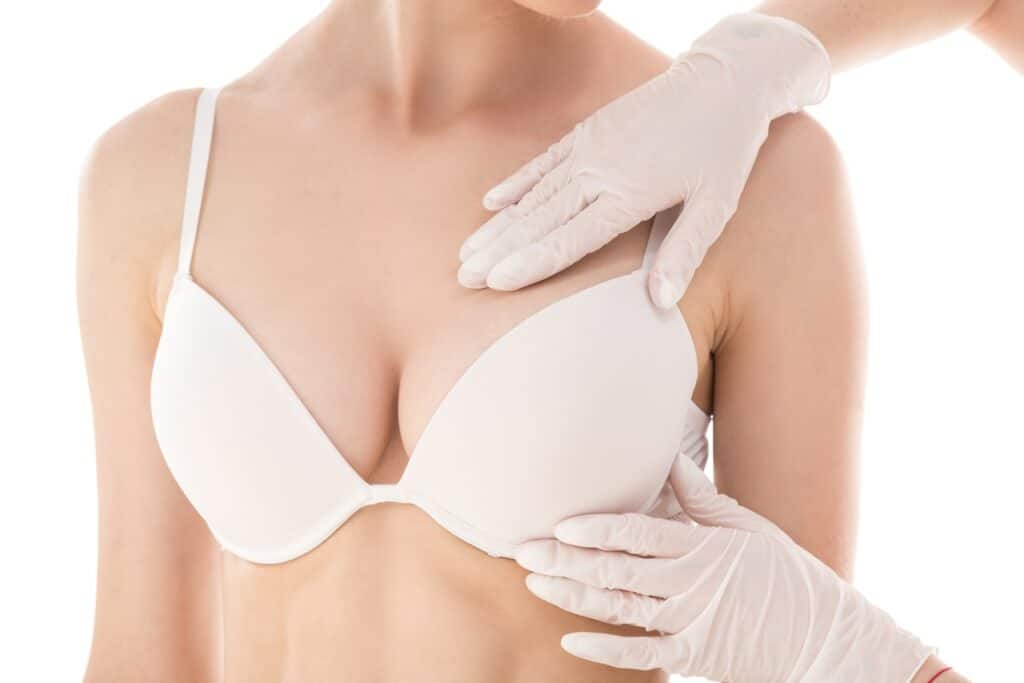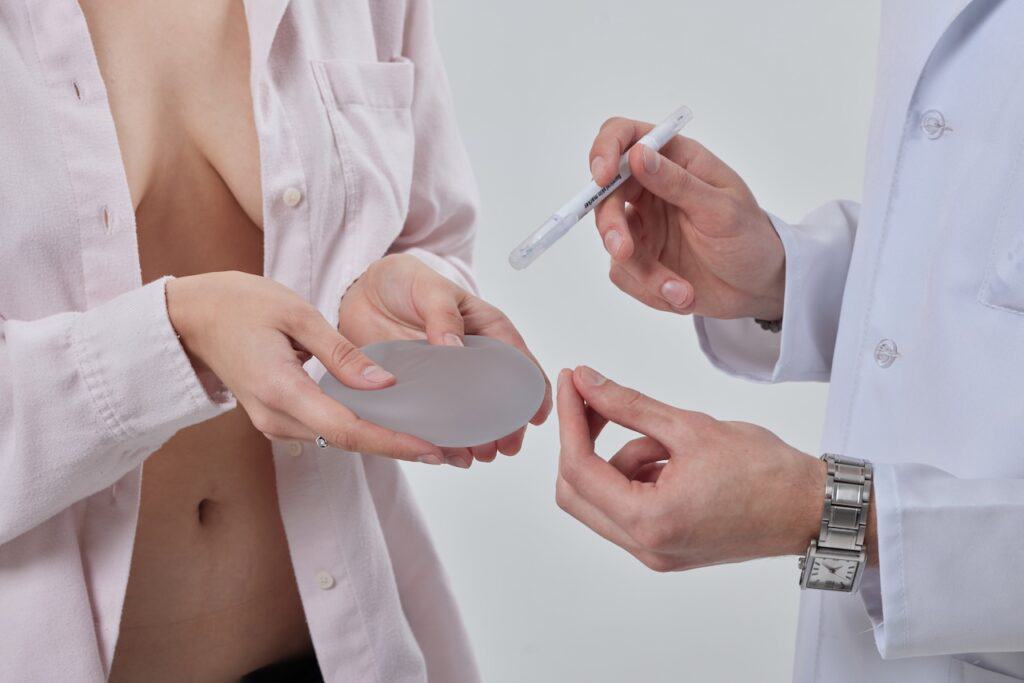Are you looking to enhance your breast size? At the New York Liposuction Center, we specialize in breast augmentation surgery.
What is Breast Augmentation?
Breast augmentation is a surgical procedure designed to enhance the size, shape, and symmetry of your breasts.
It can involve the placement of implants or, in some cases, fat transfer to achieve a fuller appearance. Many people undergo this procedure to restore volume lost due to aging, weight changes, or pregnancy.
The goal is to create a natural and proportionate look that enhances your overall body and boosts your confidence.
And while breast augmentation focuses on improving the appearance of your chest, it can sometimes draw attention to nearby areas like the abdomen, back, or flanks.
This is where liposuction becomes an excellent solution. By removing excess fat in these areas, liposuction helps ensure that your enhanced breasts work perfectly with the rest of your body.

Areas to Target with Liposuction
When pairing liposuction with breast augmentation, certain areas are more commonly addressed. Here are a few popular choices:
- Abdomen: Liposuction in the abdominal area removes excess fat and creates a flatter, more toned stomach
- Flanks (love handles): Sculpting the flanks results in a smoother and more defined waistline
- Back: Removing bulges or rolls from the back enhances the overall figure and complements your breast enhancement
- Thighs: Slimming down the thighs contributes to a more proportional and streamlined appearance
Each body is unique, and the areas we target will depend on your goals. I’ll help you decide what works best for your frame.
Benefits of Combining Procedures
Patients who choose to combine breast augmentation with liposuction often rave about their results. Addressing multiple areas at once creates a noticeable and dramatic transformation.
It enhances your overall body shape, which allows you to feel more confident and comfortable in your skin. Plus, having both procedures done at the same time reduces overall recovery time and allows you to see comprehensive results sooner.
Am I a Good Candidate?
To determine whether combining these procedures is right for you, consider the following factors:
- You are in good overall health: Candidates should be free of serious medical conditions and maintain a stable weight to ensure safe and effective results
- You have realistic expectations: It’s important to understand what these procedures can achieve and to have goals that align with the possibilities of surgery
- You want a more proportional look: If enhancing your breasts might make other areas stand out, liposuction can help balance your body
- You have stubborn fat in specific areas: Ideal candidates for liposuction have localized fat deposits that haven’t responded to diet and exercise efforts
If these points resonate with you, then breast augmentation combined with liposuction may be the perfect path to achieve your dream look.
For patients interested in comprehensive body sculpting, we might also discuss complete body reshaping or targeted midsection contouring.
Breast Aug Surgery
Breast augmentation and liposuction are performed in a single session to streamline the process and optimize your results. Here’s what to expect during the surgery:
- Anesthesia: You’ll be placed under general anesthesia to ensure your comfort throughout the procedure.
- Implant placement: For breast augmentation, I’ll insert implants either under the chest muscle or directly behind the breast tissue. This will depend on your anatomy and desired outcome.
- Liposuction process: Using a thin tube called a cannula, I’ll gently remove excess fat from targeted areas like your abdomen, flanks, or back to sculpt and refine your body.
- Surgical closure: Once the procedures are complete, the incisions will be carefully closed with sutures to promote optimal healing.
The entire procedure typically takes about 2 to 4 hours, depending on the complexity and the areas being treated. My team and I will ensure your safety and comfort every step of the way.
Note that some patients combine breast enhancement with a restorative breast lift or explore targeted upper arm sculpting for even more results.

Recovery
Recovery is an essential part of your journey, and I’ll be with you throughout the process to ensure a smooth healing experience. Here’s what to expect:
- Immediate post-op period: You’ll wake up in a recovery room where our team will monitor you as the anesthesia wears off. You’ll likely feel some soreness, swelling, and tightness in the treated areas, which is completely normal.
- Managing discomfort: I’ll prescribe medications to help control pain and minimize swelling during the first few days.
- Compression garments: You’ll need to wear specialized compression garments to reduce swelling and support your body as it heals. These garments also help ensure that your new contours settle properly.
- Resuming activities: Light activities like short walks are encouraged to promote circulation and prevent blood clots. However, you’ll need to avoid heavy lifting and strenuous exercise for about four to six weeks.
- Follow-up care: Regular follow-up appointments allow me to monitor your progress and address any concerns. These check-ins are crucial to achieving the best possible results.
With proper care and patience, you’ll begin to see your stunning new look take shape in the weeks following surgery. My goal is to help you feel confident and happy with your results.
Fat Transfer
If you’re looking for a more natural approach, fat transfer breast augmentation may be an option. This technique (similar to a BBL procedure), uses fat harvested from liposuction to enhance the size and shape of your breasts.
It’s a great choice for those who want a subtle boost without implants. However, fat transfer isn’t for everyone. We’ll discuss whether this method aligns with your goals during your consultation.
I understand that choosing breast augmentation is both exciting and personal. My approach focuses on creating natural-looking results that align with your unique body proportions and lifestyle goals.
Frequently Asked Questions
Here are answers to common questions my patients ask during breast augmentation consultations.
Q: How do I choose the right implant size?
A: We use a comprehensive sizing system during consultation, considering your body frame, lifestyle, and aesthetic goals to select the perfect implant size for natural-looking results.
Q: Can I combine fat transfer with implants?
A: Yes, some patients benefit from a hybrid approach using both implants and fat transfer. This can create more natural-looking results with enhanced soft tissue coverage.
Q: When can I return to exercise?
A: Light walking begins immediately after surgery. Most patients return to full exercise routines within 6-8 weeks, following a carefully planned progression of activities.
Q: How long do implants last?
A: While implants aren’t lifetime devices, modern implants are highly durable. We’ll discuss monitoring recommendations and potential future maintenance during your consultation.
Q: Will I have visible scars?
A: I use careful incision placement techniques to minimize visible scarring. Most patients find their scars fade significantly with proper care and time.
Take the first step with a personalized consultation at the New York Liposuction Center. Together, we’ll create a customized surgical plan that addresses your unique needs and helps you achieve natural-looking results.
Schedule a Free Consultation
Fill out the form or at call us at (917) 809-7787 to schedule your free consultation with the New York Liposuction Center and get started on your liposuction journey.